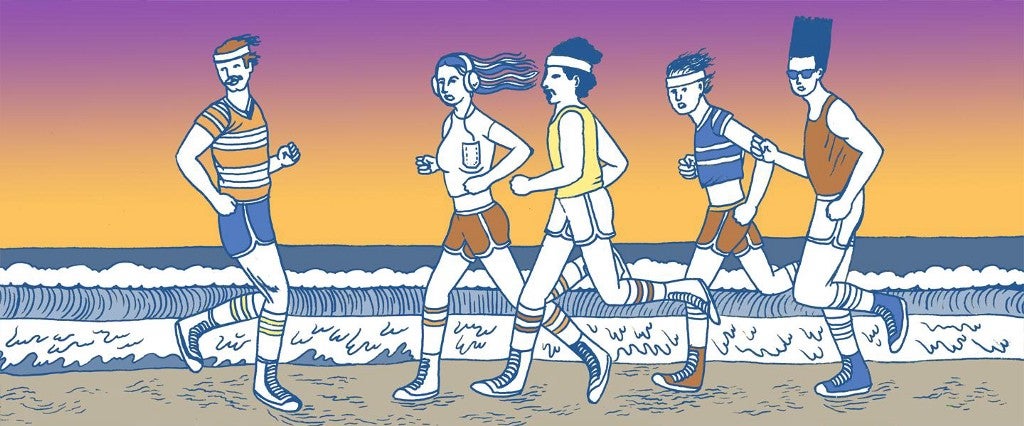Aaron Yoder, 31, is the head track-and-field and cross-country coach at Bethany College in Kansas. He’s also one of the world’s greatest backward runners, which is exactly what it sounds like (jogging, sprinting or racing backward instead of forward).
I do my workout very early in the morning so not many people see it. But in the beginning, when they did, they would good-naturedly shout, “You’re going the wrong way!” Others would film me doing a workout on the treadmill. During one run on the track, a group of kids were laughing and trying to race me — but by the end they were running backward, too. Now the only looks I get are if I’m running forward. They’re like, “What’re you doing? You’re a backward runner, run backward.”
I’ve been running — first forward, now backward — my whole life. I grew up on a dairy farm outside of Peabody, Kansas. My dad, who was a collegiate runner, started a track program in Peabody, so my three brothers and I all became runners, too. We won some state titles in high school — I was state champion in the mile — and we all ended up at Fort Hays State University on track scholarships.
I didn’t slow down until I’d been working at Bethany College as a track coach for seven years. It got to the point where my knees felt like they were grinding whenever I ran. Three years ago, my doctor told me, “You should never run again.” While I ignored him, I was in a lot of pain and started to wonder, What am I gaining from this? I was also in the midst of a taxing summer full of training camps and some funerals, and I was feeling overwhelmed at work since I had just become the head track coach in addition to being the head cross-country coach.
That’s when I had an epiphany. It was as if a voice said to me, “Just turn it around and make good of the bad.” I decided then and there that I was only gonna run backward for six weeks, and see how it went.
My first backward run was a 4-miler out in the country. Afterward, I was like, “Wow, that felt really good and better than running forward.” It’s a great core workout because so much of it is about balance. You feel it a lot more in the hip flexors, calves and quads — your quads just get rocked. It’s so painful. But it’s a good kind of pain. Distance runners enjoy feeling tortured; it’s a lot like that.
I didn’t change anything else about my training — just the direction I faced. I’d do a speed day. I’d do a hill day. I’d do a tempo day. I’d do a distance day. I’d do an acceleration day. All backward. After six weeks, my body and mind felt so much better.
That’s when I decided to try to set the Guinness World Record in the backward mile. I told one of my friends who does photography, “Hey Jim, get ready to film a world record.” The day I did it was perfect — an unbelievable 60 degrees at the end of November. The Guinness people didn’t accept it until February, though. While it wasn’t a big explosion of attention, it was still kind of nice.
A few months later, I traveled to Essen, Germany, for the International Retro Running World Championship, the Olympics of backward running. I’d never raced backward around a track before, but I quickly discovered that it’s the opposite of racing forward in some ways. When you’re running forward it’s an advantage to be right behind the leader so you know when to start making your move — because if you’re out in front you don’t know where everyone’s at. But in backward running, the best position to be in is the front. That way you can see where everyone is. The sprints, though, can be difficult because you’ve gotta worry about staying in your lane, which is hard when you’re going around turns.
Not that it took all that long to get the hang of it. The first day, I ran the 800 meters and won it. I also won the 1,500 meters and the 5,000 meters; I got second place on a 4×100-meter relay team. There weren’t enough Americans for that event so they put me on an international team.
There were at least 50 to 100 people in the crowd at all times. The medal ceremonies were cool, too. They had all of the flags lined up on the infield and the podium right in the middle. They handed you a medal on this nice silver platter, and then they would give you gifts and little certificates. Finally, they would play your national anthem. I was like, “This is so crazy!” Everybody came out of the stands and people were taking pictures and singing along.
I’ve accomplished a lot of running goals in my life, but not even in my wildest dreams would I have thought I would win a world championship. Beyond that, running backward is just fun. One of the biggest rushes I’ve ever gotten in life is when I’m running backward in complete darkness and going downhill. Your awareness is so high because you can’t see a thing.
That said, it’s all pretty safe. I can usually make out any big obstructions — for example, grain trucks or work trucks — from about a half a mile away. And when I’m doing a mile run, I look back once or twice just to see if a car is coming. Even if I hit a rock or something, my toe is down so it’s not necessarily gonna throw me off.
Overall, it feels as though time has gone in reverse, too. My body feels better than it ever has. My mind as well. Instead of looking at everything in a forward-vision way of thinking, backward running has allowed me to look at things like, Hey, look how far you’ve come. Because that’s what you’re looking at when you run backward. You’re not looking at where you’re going, you’re looking at where you’ve come from. That’s when you start thinking about all the lessons you might have missed along the way.
— As told to Adam Elder

